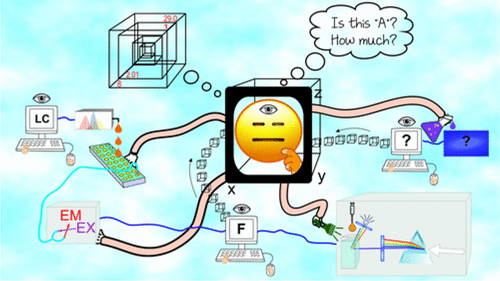当前位置:
X-MOL 学术
›
Anal. Chem.
›
论文详情
Our official English website, www.x-mol.net, welcomes your feedback! (Note: you will need to create a separate account there.)
Open-Source Assisted Laboratory Automation through Graphical User Interfaces and 3D Printers: Application to Equipment Hyphenation for Higher-Order Data Generation
Analytical Chemistry ( IF 7.4 ) Pub Date : 2017-09-25 00:00:00 , DOI: 10.1021/acs.analchem.7b02758 Gabriel G. Siano 1, 2 , Milagros Montemurro 1, 2 , Mirta R. Alcaráz 1, 2 , Héctor C. Goicoechea 1, 2
Analytical Chemistry ( IF 7.4 ) Pub Date : 2017-09-25 00:00:00 , DOI: 10.1021/acs.analchem.7b02758 Gabriel G. Siano 1, 2 , Milagros Montemurro 1, 2 , Mirta R. Alcaráz 1, 2 , Héctor C. Goicoechea 1, 2
Affiliation

|
Higher-order data generation implies some automation challenges, which are mainly related to the hidden programming languages and electronic details of the equipment. When techniques and/or equipment hyphenation are the key to obtaining higher-order data, the required simultaneous control of them demands funds for new hardware, software, and licenses, in addition to very skilled operators. In this work, we present Design of Inputs–Outputs with Sikuli (DIOS), a free and open-source code program that provides a general framework for the design of automated experimental procedures without prior knowledge of programming or electronics. Basically, instruments and devices are considered as nodes in a network, and every node is associated both with physical and virtual inputs and outputs. Virtual components, such as graphical user interfaces (GUIs) of equipment, are handled by means of image recognition tools provided by Sikuli scripting language, while handling of their physical counterparts is achieved using an adapted open-source three-dimensional (3D) printer. Two previously reported experiments of our research group, related to fluorescence matrices derived from kinetics and high-performance liquid chromatography, were adapted to be carried out in a more automated fashion. Satisfactory results, in terms of analytical performance, were obtained. Similarly, advantages derived from open-source tools assistance could be appreciated, mainly in terms of lesser intervention of operators and cost savings.
中文翻译:

通过图形用户界面和3D打印机的开放源代码辅助实验室自动化:应用于设备断字以生成高阶数据
高阶数据生成意味着一些自动化挑战,这主要与隐藏的编程语言和设备的电子详细信息有关。当技术和/或设备连字符是获取高阶数据的关键时,除了非常熟练的操作员外,对它们的要求的同时控制还需要用于新硬件,软件和许可证的资金。在这项工作中,我们介绍了带有Sikuli的输入输出设计(DIOS),这是一个免费的开源代码程序,它为自动化实验程序的设计提供了通用框架,而无需事先具有编程或电子知识。基本上,仪器和设备被视为网络中的节点,并且每个节点都与物理和虚拟输入和输出相关联。虚拟组件 诸如设备的图形用户界面(GUI)之类的信息通过Sikuli脚本语言提供的图像识别工具进行处理,而其物理对应项的处理则通过改编的开源三维(3D)打印机来实现。我们研究小组先前报道的两个与动力学和高效液相色谱法衍生的荧光基质有关的实验被改编为以更自动化的方式进行。就分析性能而言,获得了令人满意的结果。同样,主要是在减少操作员干预和节省成本方面,可以赞赏从开源工具协助中获得的优势。而使用相应的开放源代码的三维(3D)打印机来处理其物理副本。我们研究小组先前报道的两个与动力学和高效液相色谱法衍生的荧光基质有关的实验被改编为以更自动化的方式进行。就分析性能而言,获得了令人满意的结果。同样,主要是在减少操作员干预和节省成本方面,可以赞赏从开源工具协助中获得的优势。而使用相应的开放源代码的三维(3D)打印机来处理其物理副本。我们研究小组先前报道的两个与动力学和高效液相色谱法衍生的荧光基质有关的实验被改编为以更自动化的方式进行。就分析性能而言,获得了令人满意的结果。同样,主要是在减少操作员干预和节省成本方面,可以赞赏从开源工具协助中获得的优势。就分析性能而言,获得了令人满意的结果。同样,主要是在减少操作员干预和节省成本方面,可以赞赏从开源工具协助中获得的优势。就分析性能而言,获得了令人满意的结果。同样,主要是在减少操作员干预和节省成本方面,可以赞赏从开源工具协助中获得的优势。
更新日期:2017-09-26
中文翻译:

通过图形用户界面和3D打印机的开放源代码辅助实验室自动化:应用于设备断字以生成高阶数据
高阶数据生成意味着一些自动化挑战,这主要与隐藏的编程语言和设备的电子详细信息有关。当技术和/或设备连字符是获取高阶数据的关键时,除了非常熟练的操作员外,对它们的要求的同时控制还需要用于新硬件,软件和许可证的资金。在这项工作中,我们介绍了带有Sikuli的输入输出设计(DIOS),这是一个免费的开源代码程序,它为自动化实验程序的设计提供了通用框架,而无需事先具有编程或电子知识。基本上,仪器和设备被视为网络中的节点,并且每个节点都与物理和虚拟输入和输出相关联。虚拟组件 诸如设备的图形用户界面(GUI)之类的信息通过Sikuli脚本语言提供的图像识别工具进行处理,而其物理对应项的处理则通过改编的开源三维(3D)打印机来实现。我们研究小组先前报道的两个与动力学和高效液相色谱法衍生的荧光基质有关的实验被改编为以更自动化的方式进行。就分析性能而言,获得了令人满意的结果。同样,主要是在减少操作员干预和节省成本方面,可以赞赏从开源工具协助中获得的优势。而使用相应的开放源代码的三维(3D)打印机来处理其物理副本。我们研究小组先前报道的两个与动力学和高效液相色谱法衍生的荧光基质有关的实验被改编为以更自动化的方式进行。就分析性能而言,获得了令人满意的结果。同样,主要是在减少操作员干预和节省成本方面,可以赞赏从开源工具协助中获得的优势。而使用相应的开放源代码的三维(3D)打印机来处理其物理副本。我们研究小组先前报道的两个与动力学和高效液相色谱法衍生的荧光基质有关的实验被改编为以更自动化的方式进行。就分析性能而言,获得了令人满意的结果。同样,主要是在减少操作员干预和节省成本方面,可以赞赏从开源工具协助中获得的优势。就分析性能而言,获得了令人满意的结果。同样,主要是在减少操作员干预和节省成本方面,可以赞赏从开源工具协助中获得的优势。就分析性能而言,获得了令人满意的结果。同样,主要是在减少操作员干预和节省成本方面,可以赞赏从开源工具协助中获得的优势。


























 京公网安备 11010802027423号
京公网安备 11010802027423号